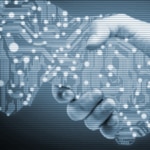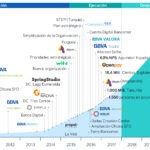BBVA is leading the pack in terms of technology applied to finance - from electronic payments in day-to-day transactions with BBVA Wallet, to big data management. But on the horizon has appeared the (pen)ultimate frontier that banks will need to cross, one that has a sci-fi ring to it: the robotization of banking activities.

What is it all about? The ultimate goal of robotization is improving the profile of the market analyst and using current technological capabilities to expedite the understanding and management of information. At a time when the overabundance of data can mire the path of the analyst, machines bring the promise of a yellow brick road towards more relevant variables.
Ridley Scott’s ‘Blade Runner’ is not here yet. And this is a road that machines cannot travel alone. The human element is pivotal in the world of finance. The next link in the chain is, in Francisco González’s own words “not holding progress back,” but adapting to it. A symbiosis.

A team of two
It's easy to imagine a mixed system, where a manager makes the final decision based on a series of data acquired from a machine. Big banks - and their turnover figures - are already seeing their activity simplified and bolstered by the effective use of “zeroes and ones”.
JP Morgan has already successfully tested this strategy. As Bloomberg reports, after pouring about $3 billion into innovation investments, the firm has finally found a program that identifies which clients are better positioned for tracking equity offers and sends this information to its analysts. The result? Its investment bankers can tap into new business streams more easily, improving their performance.
As Víctor Alvargonzález notes in an article for El Confidencial, machines have a tiny problem: “they have trouble getting along with people.” Despite the unstoppable and game-changing nature of the tech revolution, the human element is still pivotal in financial relationships.
The road travelled
BBVA is in a privileged position. The company launched its own technological transformation a decade ago and now has the capability to face current challenges building on well-established pillars. The recent success of blockchain technology applied to syndicated loans is a good example thereof.
The need to update the strategy to embrace technology is something that is absolutely clear for BBVA CEO Carlos Torres: “Data have become the basis of the relationship with customers” and we need to act in accordance with their development.

Timeline BBVA’s transformation Journey
User traceability
The most current example would be the management of big data itself. Today, the name of the game is not collecting and amassing data, but making sense out of the millions of terabytes of data generated by the virtual activity of millions of internet users. The goal is to micro-segment the market down to the scale of each customer’s day-to-day life.
This process, linked to big data, is slowly finding its way into the ecosystem of investments and big banks. Unique and extremely relevant information that can give the analyst an edge to capitalize on the economic flows.
Do banks dream of electric sheep?
Innovation is a trial and error process. The efforts by investment banks such as JP Morgan or Goldman Sachs to automate certain investment transactions - notably, the Blackrock project, which envisages entrusting the management of about $30 billion in assets to an IT system - have reopened the debate over the evolution of the financial system.
The key lies in being able to create a work culture that adapts and positively absorbs the disruptive elements that technology brings, by combining a machine’s data structuring capabilities with the analyst's expertise and human “touch," and integrating them within the technological ecosystem.
Because the future will not arrive in flying cars, but when it does, it will still need drivers behind the wheel.